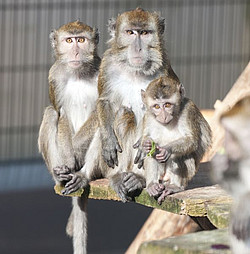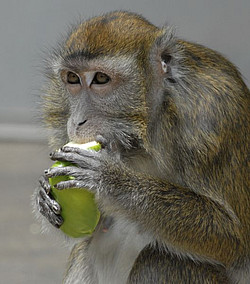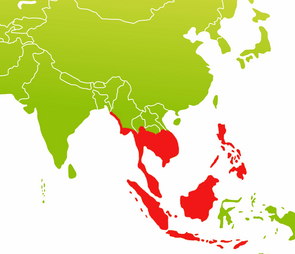Long-tailed macaque
The long-tailed as well as the rhesus belong to the genus macaque. Their distribution area extends from Bangladesh and Myanmar in the west across Malaysia and Indonesia in the south to the Philippines. Currently, primatologists can distinguish between ten different subspecies that partly live on isolated islands and differ in the color of their fur, tail length, and the shape of the cheek hair.
Special features
Eye-catching is the brown-gray face of the long-tailed macaque with a defined white mark above the eyelids and the typical whiskers. Unlike the rhesus macaque, the long-tailed macaque has a very long tail, which is usually up to 70 centimeters long and is longer than the rest of the animal. On average, the males are up to ten centimeters taller than the females and are usually twice their weight. The males also have much larger canines than the females.
Habitat and lifestyle
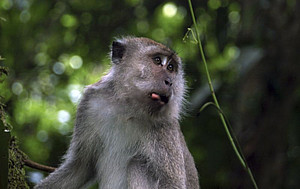
Long-tailed macaques usually live near water and wetlands in rain, bamboo and mangrove forests. For the most part of the day they are on trees and only come down in search of food. In addition, long-tailed macaques are also found in plantations, gardens and fields near human settlements. Their home ranges are highly variable and could include several hundred acres. Depending on the size of the group, the monkeys walk up to two kilometers daily.
Nutrition
Long-tailed macaques are omnivores and as part of their diet, they prefer fruits. In addition, they consume flowers, leaves, buds, and other parts of plants. They also eat insects, crustaceans and fish. In coastal regions living long-tailed macaques also like to eat crabs, which is why they are also called "crab eaters".
Social behavior and reproduction
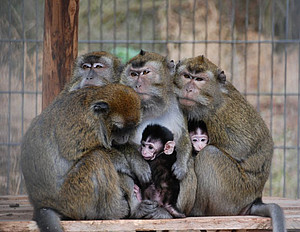
As all the other macaques, long-tailed macaques live in social groups of 6 to 60. The groups usually consist of several males, females and infants and are organized in fixed hierarchies. The order of the hierarchy is reflected in the access to food, grooming and mating. The females tend to remain in their natal group throughout their lifetime. As soon as the males reach puberty, they leave the group accompanied by bachelors and other young males. Before they find a new group, which they take over with a higher ranked male. The females can reach sexual maturity when they are around three and a half years old, males usually with five to six years. Mating and births occur throughout the year. However, during the rainy season from May to July, they are more frequent. After a gestation period of 160–168 days, the female gives birth to one infant. The infant weighs around 300 to 600 gram and is nursed for up to 22 months by the mother. The newborn has a black-brown fur that changes to a lighter color around the age of two to three months.
Source: Handbook of the Mammals of the World: Primates (edited by Mittermeier, R.A., Ryland, A.B., Wilson D.E., published by Lynx Edicions, Conservation International, IUCN, 2013)
Profile of the long-tailed macaque
| Scientific name | Macaca fascicularis |
|---|---|
| Taxonomy | Suborder: Old World monkeys Family: Subfamily: Tribe: Genus: Species: |
| Distribution | Southeast Asia (Southern Laos, South Vietnam, Cambodia, Thailand, Malaysian peninsula, Borneo, Sumatra, Java, Bali, Philippines, Southwest Bangladesh, South Myanmar) |
| Head and body length | 37 - 63 cm 31.5 - 54.5 cm |
| Tail length | 36 - 71.5 cm 31.5 - 62.8 cm |
| Weight | 3.4 - 12 kg 2,4 - 5,4 kg |
| Diet | fruits, leaves and other parts of plants, shellfish, crabs, mussels, snails, insects, fish |
| Lifestyle | diurnal, mostly arboreal |
| Social organization | mixed-gender groups, hierarchies in both sexes |
| Mating system | promiscuous |
| Life expectancy (husbandry) | up to 35 years |
| Status (IUCN Red List) | least concern |

